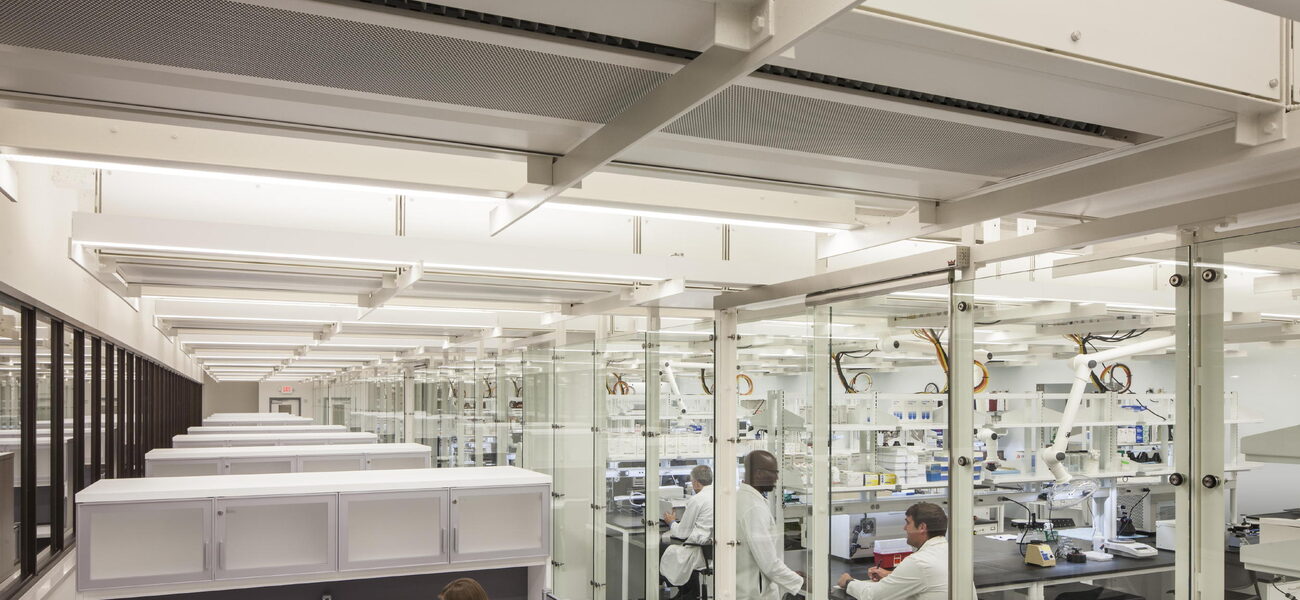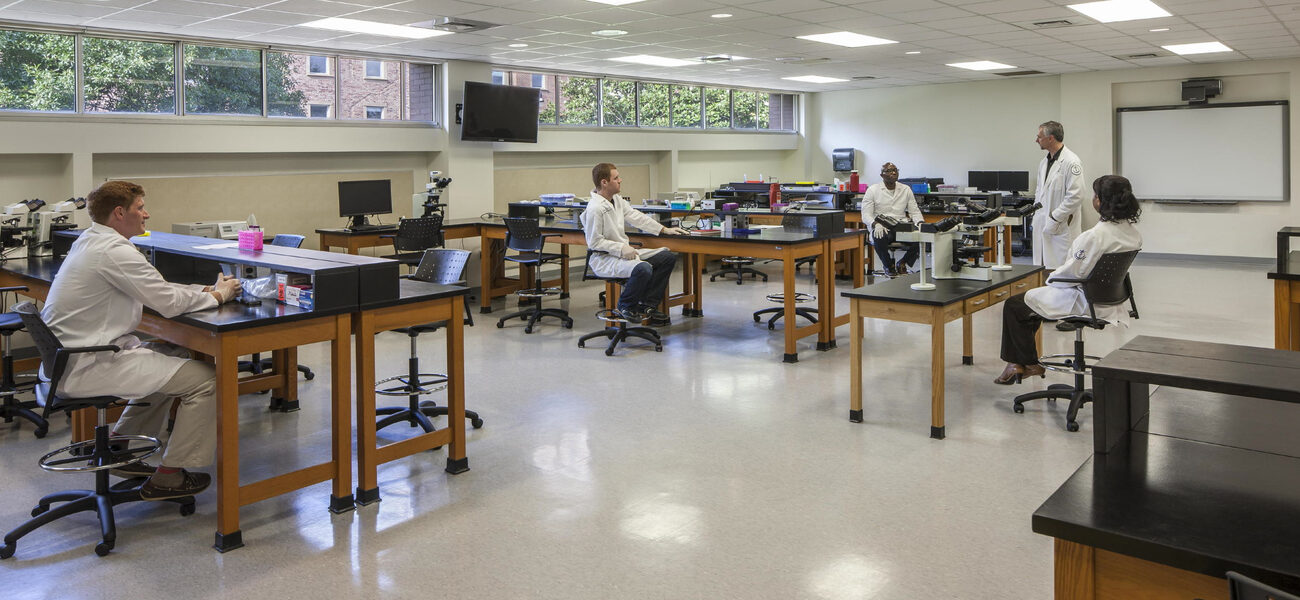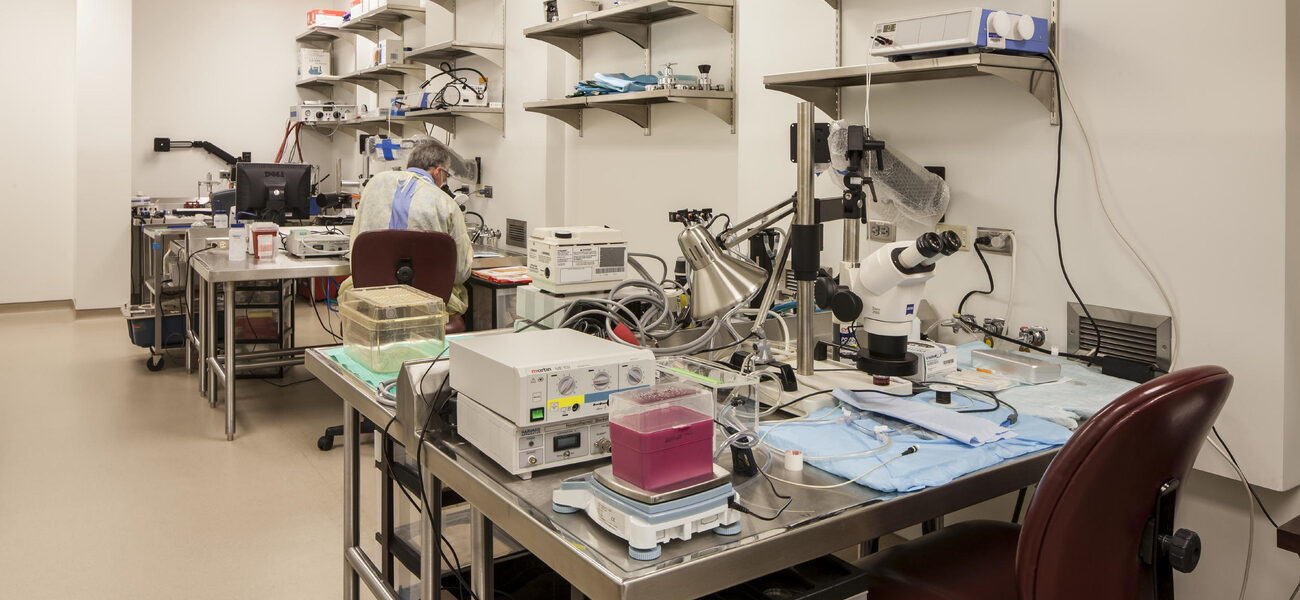The Morehouse School of Medicine (MSM) has completed Phase I of a renovation and expansion project aimed at increasing the size of its entering medical doctor class by 78 percent, from 56 students in 2009 to 100 by 2016. Phase I involved four relatively small projects—all renovations of existing space—that will have a major programmatic impact: the addition of a state-of-the-art animal surgery suite, a graduate teaching laboratory, a renovated library, and a renovated research laboratory that consolidates MSM’s four core biomedical research areas.
The focal point of the renovation of the Neuroscience Institute in MSM’s Multidisciplinary Research Center is a 618-sf small-animal surgery suite, completed in August 2011, that comprises two animal holding rooms—one for pre-op and one for post-op—a procedure room, and a necroscopy room. The animal surgery suite enhances the Institute’s research into the effective treatment of strokes. The $490,000 Neuroscience Institute renovation, comprising a total of 4,300 sf, also includes the design of a mass spectrometry center and renovated office space.
The new $500,000, 3,022-sf graduate teaching laboratory on the second floor of MSM’s Hugh Gloster Building, completed in October 2011, provides graduate students with a much-needed site for early hands-on training in key biomedical laboratory skills, such as the use of fume hoods, tissue cultures, electrophoresis, and Western blotting. Employing a project-based active learning concept by which technology supports team learning, teams of six graduate students work together surrounded by four monitors set up around the lab perimeter. A large monitor at the front of the room allows the professor to display an image from one team’s work so that all the other teams can see it. The lab includes spaces for students to store equipment, study, eat, and interact. It also is used by students in MSM’s pipeline programs in order to encourage and prepare high school and undergraduate college students to pursue higher education, specifically careers in the sciences.
The remaining two renovation projects, located on the first and second floors of the Medical Education Building, were undertaken simultaneously. The 17,603-sf, $10 million biomedical core research lab comprises one large open research lab, eight support labs, administrative spaces, and restrooms updated to meet ADA standards. The lab, which fills the entire second floor of the building, consolidates and centralizes four research areas that had been scattered around campus: analytical chemistry and protein profiling, the biomedical technology service laboratory, cells and tissues, and gene profiling.
The consolidation also fulfills the need to optimize utilization of space for equipment, prep facilities, and human and technical resources. Added to the interstitial space is a storage room for cylinders that pipe CO2 to the lab benches and incubators, allowing vendors to refill the cylinder without having to enter the lab.
The core group research lab is targeting LEED silver certification, with electrical and mechanical upgrades such as chilled beams, glass walls that bring daylighting from the east all the way into the open lab, reduced water consumption, low-emitting materials and finishes, construction waste management, and recycled construction materials.
The first-floor $1.5 million library renovation and modernization involved consolidating and digitizing the library collection to remove rows of stacks, freeing up space to add a new circulation desk, new flexible multipurpose teaching space, archival and administrative support space consisting of 24-hour teaming (study) rooms and conference rooms, and informal reading areas in a brighter setting. The 24-hour study rooms, which can accommodate six students each, include power along the walls for Internet and MSM network access and an interactive white board to encourage team collaboration.
The library was completed in March 2013, the core lab in August 2013.
| Organization | Project Role |
|---|---|
|
Architect
|
|
|
C.D. Moody Construction
|
Builder (Surgery Suite)
|
|
DPR Construction, Inc.
|
Builder (Graduate Teaching Lab)
|
|
Turner Construction
|
Builder (Library and Second-Floor Lab Renovation and Research Core)
|
|
BAA Mechanical Engineers
|
MP/FP Engineer
|
|
Womack Lundstrom
|
Electrical Engineer, Consultant to BAA Mechanical
|
|
Dober Lidsky Mathey
|
Campus and Facility Manager (Master Plan)
|
|
Clement & Wynn
|
Program Manager (Master Plan)
|
|
Carrier Corp.
|
Packaged Air-Cooled Chillers and Air Handling Units (Second Floor and Research Core)
|
|
ABB
|
Adjustable Frequency Controller (Second Floor and Research Core)
|
|
SEMCO Incorporated
|
Energy Recovery Units and Active Chilled Beams (Second Floor and Research Core)
|
|
Siemens
|
Deionization Recirculating Water System (Second Floor and Research Core)
|
|
Siemens
|
HVAC Automatic Controls (Second Floor, Research Core, and Library)
|
|
Watts
|
Reverse Osmosis System (Second Floor and Research Core)
|
|
Environmental Growth Chambers
|
Environmental Control Room (Second Floor and Research Core)
|
|
STERIS Corporation
|
Sterilizer and Glassware Washer (Second Floor and Research Core)
|
|
Stonhard
|
Resinous Flooring (Second Floor and Research Core)
|
|
Mitsubishi
|
Ductless Split System Heat Pump (Library)
|


